A Brief History of New York City’s Oldest Pizzerias
By Ian MacAllen on Tuesday, October 10th, 2023 at 2:21 am | 24,828 views
Pizza was born in Naples, but it was the Italian immigrants in New York City who mastered it. Today, pizza grown into a truly American food available in every corner of the country. Yet, a little more than a century ago, it was an unknown ethnic food few Americans had ever heard of.
In the 19th century working class neighborhoods of Naples, pizzaiolo lived above their shops selling fresh baked pizza. The pizzerias were highly regulated. Each required a license to operate, and the license holder had to be on premise any time the ovens were baking pizza, explaining why most license holders lived above their shop. The city official worried fires would spread through the densely packed streets. Each pizza oven was fueled with hot wood fires. Unattended ovens could easily spew embers.
At the end of the 19th century, thousands of Neapolitan-born immigrants had arrived in New York City. Bakery ovens in the city were different from those in Naples. For instance, the ovens were larger and built for baking bread at scale. And the fuel of choice in New York was coal, not wood. These two elements would eventually have a big impact on New York’s pizza resulting in larger pies baked at higher temperatures.
Lombardi’s
The “oldest” pizzeria in America, Lombardi’s first opened as a grocery store in 1897. The shop sold a variety of items and served the immigrant community around it. The store was founded by Gennaro Lombardi, likely a relative of a licensed pizzaiolo in Naples where there is also a Lombardi’s pizza. Gennaro might have been content simply selling grocery items in his new store. But eight years after opening, in 1905, Anthony Totonno Pero, a clerk in the shop, suggested they begin selling pizza.
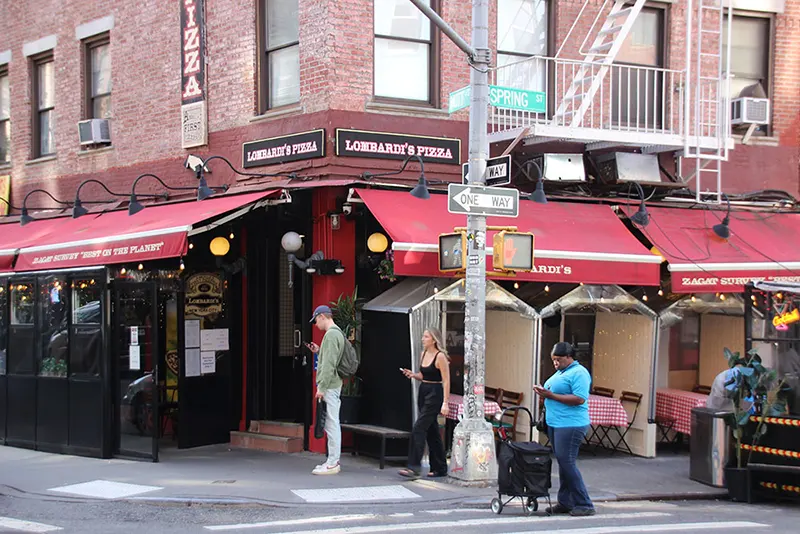
Totonno had immigrated from Naples. He knew pizza as a common street food and is largely credited with introducing the baked bread at Lombardi’s. The pizza was a successful addition, and eventually became the primary business.
When the grocery first started selling pizzas, they were for takeout only. The shop didn’t have room for tables since it was also filled with grocery items. Groceries at the time sold items in bulk, and customers weren’t allowed to roam around the aisles like a modern supermarket.
The pizza was likely sold at room temperature, and perhaps even eaten cold since the customers may not have had an oven in their tenements. But eventually, the shop evolved into a full-service Italian restaurant. Pizza was part of the menu at the restaurant, but the menu was dominated by classic Italian American fare.
Through much of the 20th century, Lombardi’s was a relatively successful Italian American restaurant. In fact, around 1980, the restaurant stopped serving pizza. A problem with the coal-fired ovens led the owners to remove the pizza from the menu rather than make a big investment repairing it. Lombardi’s continued operating as a restaurant until 1987 when it shut down entirely.
When Lombardi’s shut down, two Trenton, New Jersey area pizzerias started vying for the title of oldest pizzeria in America. Strictly speaking, Trentonians eat “tomato pie,” not pizza. The primary difference is the sequence with which the pizza is made. Trenton tomato pies are layers of dough, cheese, and then sauce while a New York pizza has the sauce between the dough and the cheese.
In 1910, Joe’s Tomato Pie opened on South Clinton Street in Trenton. Founded by Joe Silvestro, the shop was operating in the early 1990s. The shop stayed within the family, but eventually closed after the last standing family member burned out baking pies.
But Joe’s wasn’t the only Joe in Trenton selling pizza. Joe Papa’s tomato pie shop opened two years after Joe’s, in 1912. The proprietor, then seventeen-year-old Giuseppe “Joe” Papa, had started his career working at Joe’s Tomato Pie. Joe Papa’s has operated continuously since 1912 and so has since tried to claim the title of oldest pizzeria in America. However, Joe Papa’s has not been operating out of the same location for all those years having moved around Trenton several times before finally settling in Robbinsville, New Jersey where it’s now run by Nick Azzaro, Joe Papa’s grandson.
Meanwhile, Lombardi’s returned in the summer of 1994. Another Gennaro Lombardi, grandson of the original owner, partnered with pizza chef Andrew Bellucci to bring back America’s first pizza. Their state goal was recreating the original pizza as best they could, and that included sourcing high quality coal from Pennsylvania.
However, like Joe Papa’s, Lombardi’s had relocated. Instead of opening at the original location at 53 ½ Spring Street, the new restuarant opened at a corner lot at 32 Spring Street. They chose the location because it had a working coal oven.
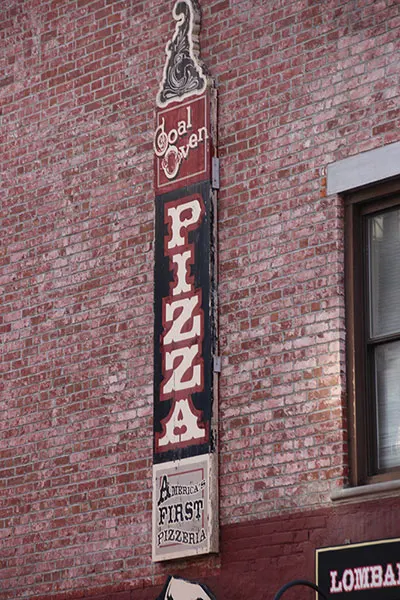
Totonno’s
While Lombardi’s may have started selling pizza first, the shop owes a debt of gratitude to Anthony Totonno Pero for introducing the product to the grocery store. It would take almost two decades, but eventually Totonno opened his own place.
In 1924, “Totonno” opened a pizzeria on Coney Island at 1524 Neptune Avenue. By the 1920s, Coney Island had developed a booming summer tourism business. Nathan’s Famous hot dogs, just a few blocks away, had been open since 1916, the BMT elevated subway in 1919.
The shop was famous for making sauce from plum-shaped San Marzano-style tomatoes and maintaining the use of fresh fior di latte, cow-milk mozzarella, rather than low moisture, shredded cheese. Fresh mozzarella-topped slices are common in the United States today, but for much of the twentieth century, pizza was topped with “pizza cheese,” a low moisture mozzarella that tastes similar to and has a consistency similar to scamorza. Totonno’s dedication to the fresh mozzarella was more novel at the time.
Another distinction about Totonno’s pies was he laid the cheese directly on the dough, similar to Trenton tomato pie, arguing the sauce would leave the dough too wet if it came in direct contact.
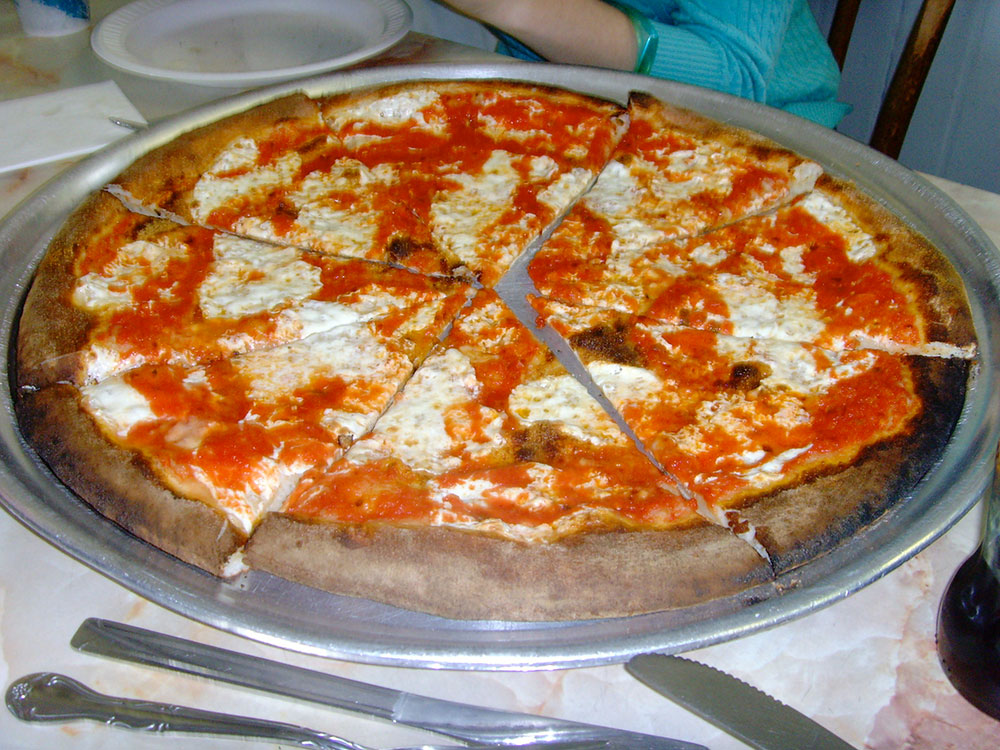
For more than half a century, the only place to get a Totonno’s pie was in Brooklyn, but in 1997, that finally changed. Totonno had resisted expanding the restaurant, but he passed away in 1994. His son Jerry Pero inherited the Brooklyn pizzeria, and his niece, Louise Ciminieri, pushed to open a new location on the Upper East Side. The location at 1544 Second Avenue, near 80th street opened with 104 seats, more than twice as many as Brooklyn’s shop. A third location opened at 462 Second Avenue.
But then in March of 2009, tragedy struck when a fire ripped through the Brooklyn shop. Totonno’s granddaughter, Antoinette Balzano oversaw the renovation, but took on massive debt to fund it. After some delays, the shop reopened later that year.
However, by 2011, both Manhattan restaurants had closed. The Upper East Side location faced a steep rent increase, and eventually became a Toscano’s coal-fired pizzeria, and the Kip’s Bay location at 462 Second Avenue had become a Grimaldi’s.
Tragedy struck again in 2012 when Hurricane Sandy ripped through Brooklyn leaving behind water damage and mold. The family again renovated, and reopened for a second time in 2013.
And finally when the COVID-19 pandemic arrived in New York City in 2020, like many family-owned businesses, Totonno’s shuttered its doors. Many feared the historic restaurant was done for good, but has begun to slowly reopen on weekends beginning in 2022.
John’s of Bleecker Street
Like Totonno, John Sasso worked at Lombardi’s before opening his own shop. In 1929, he took on a lease on Sullivan Street where he started selling pizzas. He eventually lost the lease on the first location and moved to 278 Bleecker Street around 1934 — taking his brick oven with him.
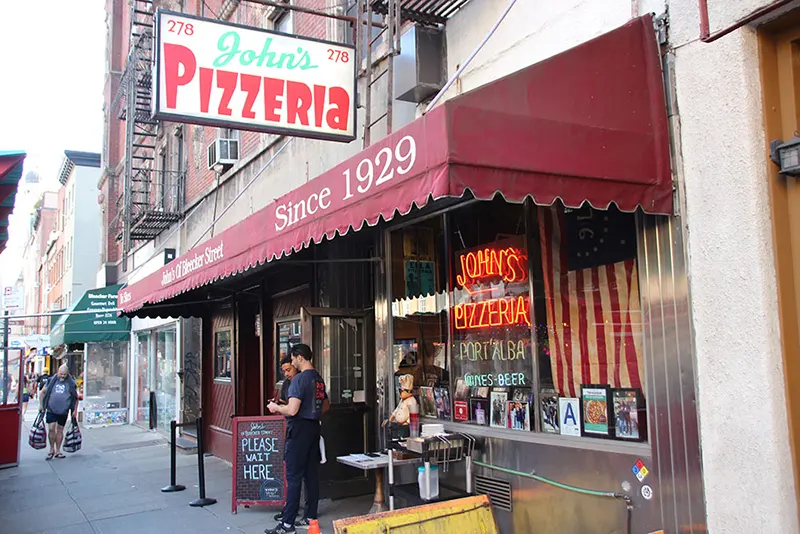
The shop has made a name for itself by refusing to sell slices. Customers can only order a whole pie. It’s even imprinted on the concrete in front of the building and on the awning overhead.
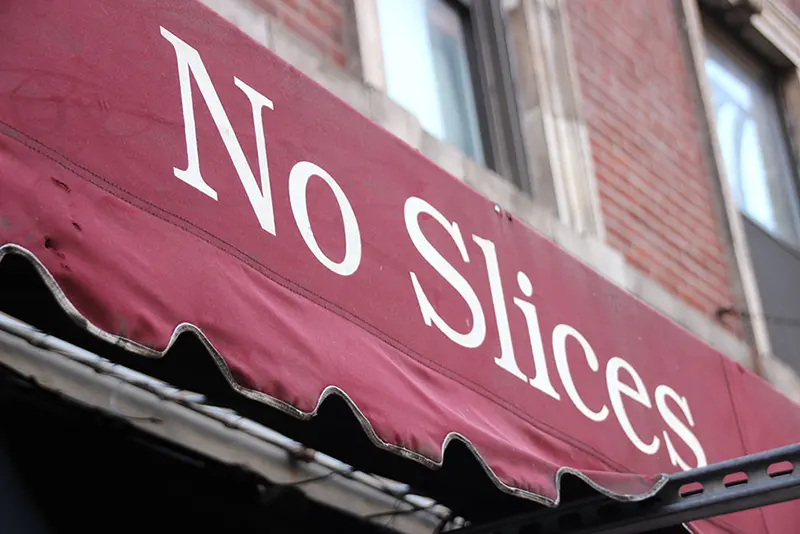
In 1955, Sasso sold the pizzeria to his brother, and then in 1973, Peter Castellotti and Robert Vittoria, great-grand-nephews of the founder, took over. They would formally buy the restaurant a few years later.
Peter Castellotti oversaw the restaurant’s expansion. The first new spot opened in the Upper East Side in 1985, and another location, called John’s of New York, in Port Charlotte, Florida. In 1993, John’s opened on the Upper West Side at 48 West 65th Street, between Broadway and Central Park West.
The John’s empire wasn’t built in a day, and it relied on complicated family entanglements that ultimately would lead to legal disputes.
By the 1990s, New York City was on the rebound, and the transformation of Times Square had begun. Madeline Castellotti envisioned opening a large format John’s in Times Square. She was at one time married to Peter Castellotti Senior and the mother of his children Peter Junior and Lisa Free. They were all involved in the family business of selling pizza, but it was Madeline who pushed for opening the Times Square location.
It was Madeline who identified the location on 44th Street — the old Gospel Tabernacle Church — as the spot to open a 400-seat restaurant, and created a separate business entity. This John’s pizza opened in 1997.
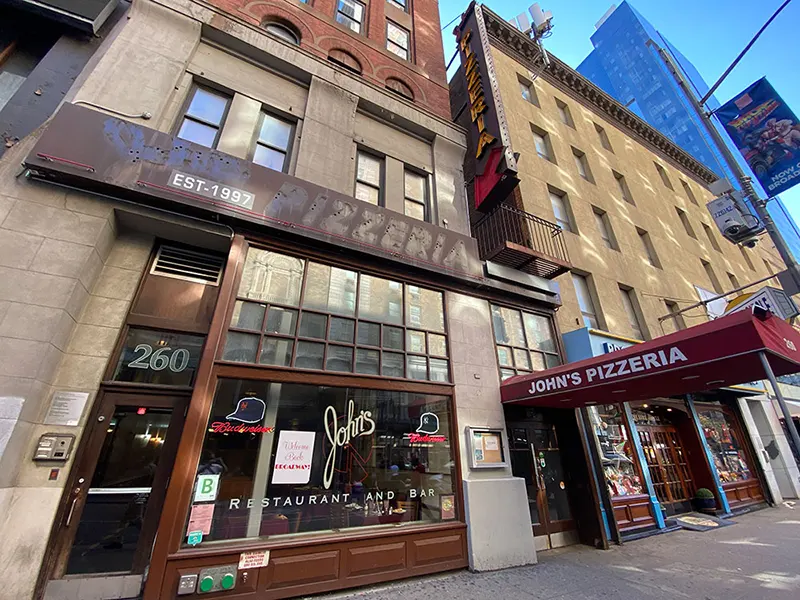
The official history of John’s of Times Square describes Madeline as a single mother, although her obituary describes Peter Senior as her loving husband. The discrepancy here might first begin to explain some of the legal disputes that began unfolding after Madeline’s death.
The new business boomed, and when Madeline passed away in 2004, her estate was worth millions. The Her death set off a legal battle that would last more than a decade.
The trouble began when Madeline cut her son out of her will. Peter Jr., had expected to inherit half of John’s of Times Square. Instead, Madeline’s entire estate was left to her daughter, Lisa Free. The decision led Peter Jr. to file a $25m lawsuit against his sister.
One reason cited for Madeline disinheriting her son is that she didn’t like her daughter-in-law. By cutting her son out of the inheritance, it ensured Peter’s wife would never see a dime of her money. However, at the time of her death, Peter Jr. was in the process of divorcing his wife, and so he claims to have made a verbal agreement with his sister to share the inheritance.
Four years later though when the divorce was final, Lisa Free didn’t uphold her half of the alleged bargain. Peter Jr filed suit.
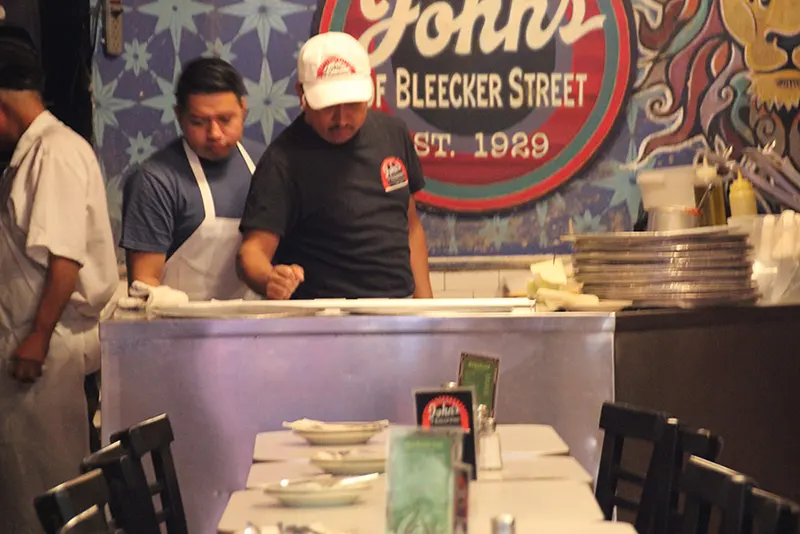
Among other things, Peter claimed that under Lisa’s management, the restaurant regularly sat 500 to 600 people, far more than allowed by the fire department. He also alleged too that fire exits were often blocked, and that Lisa bought wine at a discount with cash, bypassing distributors and state taxes. The lawsuit dragged on. Eventually, Peter Senior, Lisa’s father, also sued her after she failed to repay a loan she took from him to pay estate taxes.
The legal drama didn’t slow the burgeoning empire. Although the John’s operated by Peter Senior slowly began to shutter, John’s of Times Square started opening new offshoots. In 2008, John’s of Times Square opened a small branch in Jersey City, at 87 Sussex Street. The Paulus Hook neighborhood where John’s opened was rapidly gentrifying. A few years later, John’s also opened in the Bronx at 2376 Arthur Avenue, the heart of the borough’s Little Italy. The Jersey City location closed in 2022 after 14 years, and the Arthur Avenue location has also closed.
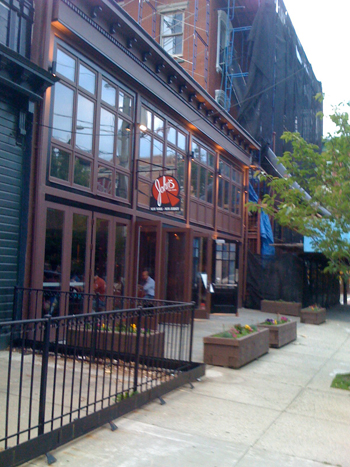
Meanwhile, at John’s of Bleecker Street, owner Bob Vittoria celebrated the 75th Anniversary of the shop in 2004. Peter Senior was still involved in the restaurant, although Vittoria had since become the majority owner. Back in 2004, both Peter Jr., and Bob’s son worked together at the restaurant too, and traditions of no slices, no reservations, and cash only remained. Celebrities Danny DeVito, Rhea Pearlman and David Faustino were frequent patrons.
John’s Upper East Side location closed in 2014 without a trace. The Upper West Side and Florida restaurants operated by Peter Senior have also closed. The original John’s on Bleeckerclosed temporarily for the pandemic but eventually reopened.
Johns on Bleecker Street and John’s of Times Square share the name John’s and a legacy derived from John Sasso’s original pizzeria, but today operate as separate businesses. While both focus on “no slices” and “whole pies” respectively, no doubt the intra-family legal disputes have taken a toll both on the personal relationships and the businesses.
Patsy’s
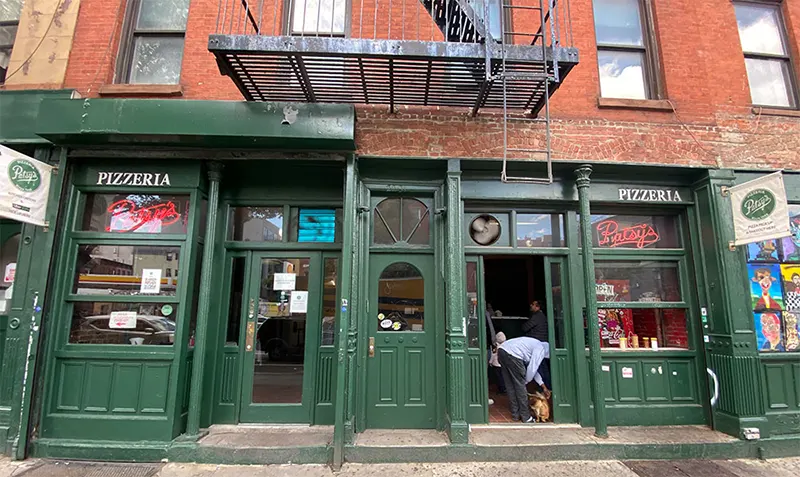
In one specific way, New York’s pizza culture didn’t start until Patsy’s opened. Patsy was an innovator, and invented the idea of selling pizza by the slice. In one fateful moment, the New York slice was born.
In 1933, Pasquale “Patsy” Lancieri opened a pizzeria with his wife Carmella in East-Harlem. At the time, the neighborhood was predominantly Italian American. The Lancieris bought two buildings on First Avenue at 118th Street, and cooked their pies in a coal-fired oven.
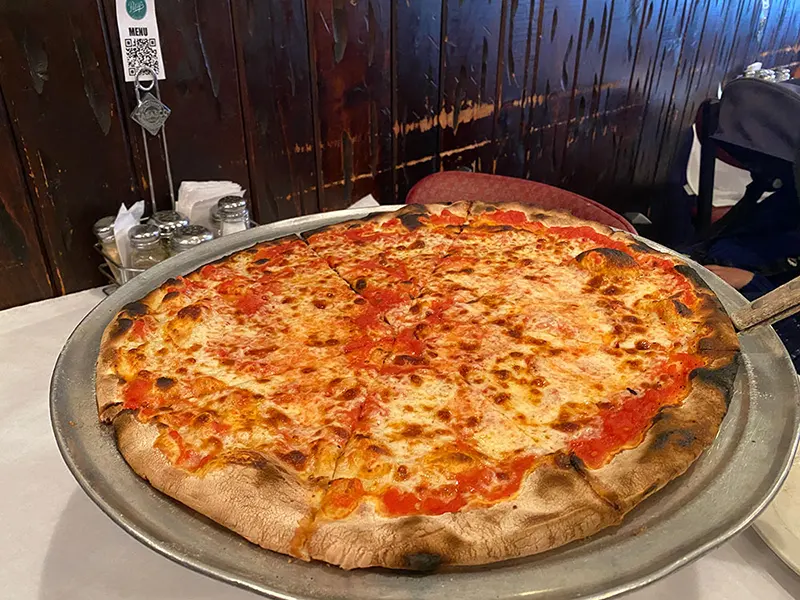
But Patsy’s Pizzeria wasn’t the only Patsy in town. In 1944, on 56th Street between 8th Avenue and Broadway, Patsy Scognamillo opened an Italian restaurant, more upscale than Patsy’s Pizzeria, and it became a celebrity hangout.
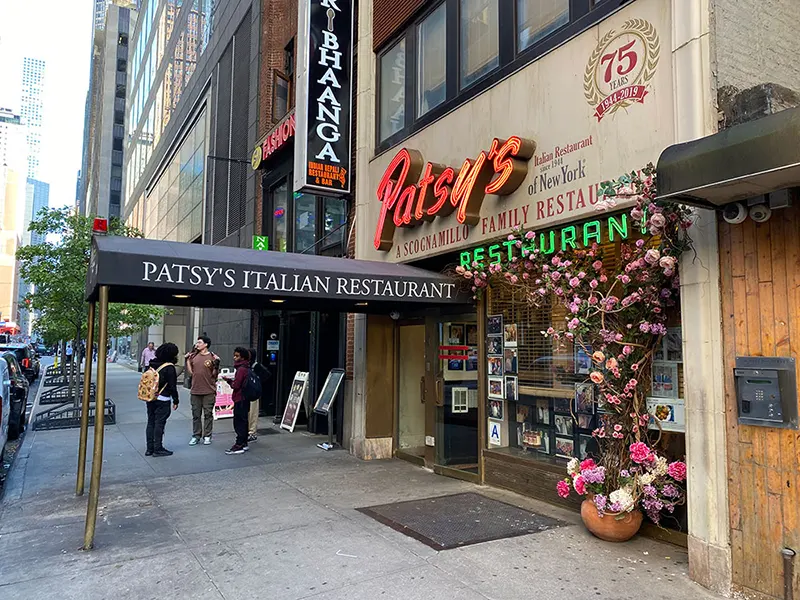
Frank Sinatra often ate there as did Dean Martin and Joe DiMaggio, and scores other famous entertainers. The restuarant even maintains a celebrity wall featuring photographs of the high profile visitors. Since his death, Patsy’s Italian Restuarant even celebrates the singer’s birthday by serving his favorite dishes.
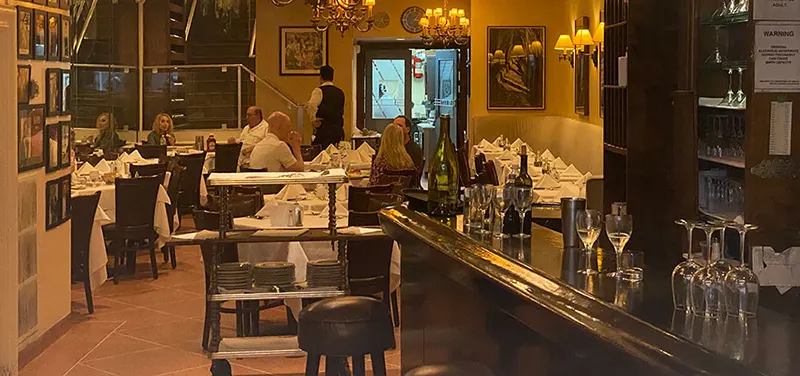
Patsy’s Pizzeria on the other hand, faced a debilitating change in the neighborhood. As New York City entered its darkest period of high crime and few city services, East Harlem suffered some of the worst effects. Then Patsy died around 1975, leaving Carmella to run the restaurant by herself.
Fifteen years later, Carmella was looking for a way out. She sold the restuarant in 1991 to Frank Brija, an Albanian born in Kosovo. And this is where the trouble began.
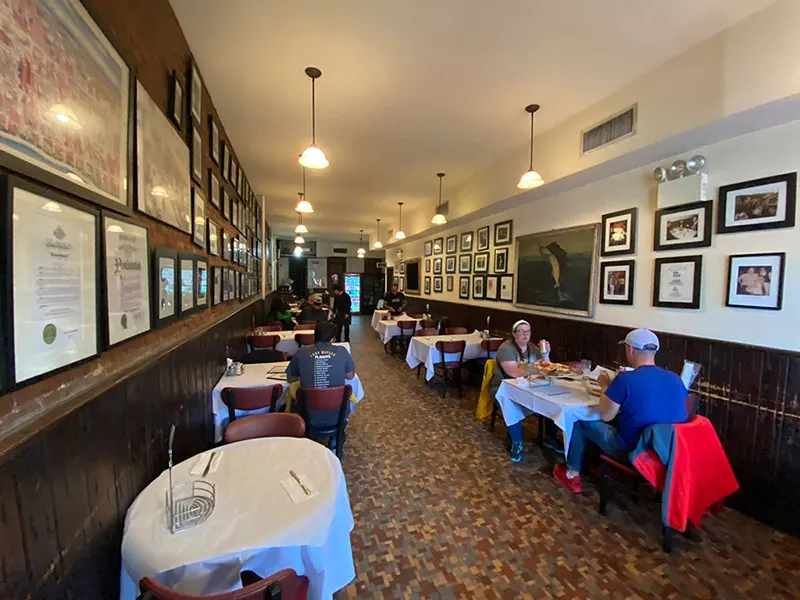
Brija began slowly renovating the aging pizzeria, investing in remaking the red sauce joint more modern – this was the height of the Tuscan trattoria craze, and red sauce was decidedly less popular than it is today.
He decided to license the name Patsy’s to Nick Tsoulos, a Greek who’s brother-in-law ran Nick’s Pizza in Forrest Hills, Queens. Tsoulos wanted to sell pizza in Manhattan and saw an opportunity in using the Patsy’s name.
Tsoulos opened five Patsy’s Pizzerias in Manhattan starting in 1995, but by then another Patsy’s pizzeria was operating in Brooklyn. That shop was owned by another Patsy–Patsy Grimaldi–a nephew of the original Patsy Lancieri. And of course, there was Patsy’s, the midtown restaurant with a celebrity following. Brija started filing for trademarks.
Over at the midtown Patsy’s Italian Restaurant, Scognamillo’s grandson Frank DiCola and his cousin, Salvatore Scognamillo, the restaurant’s chef, were about to celebrate the 50th anniversary of the restaurant. They had come up with a new side hustle: jarred sauce. Marinara was a mainstay of their pasta, and they launched the line of jarred sauce in high-end grocery stores around the city.
Brija, who by now was quite familiar with intellectual property law having already convinced the Brooklyn Patsy’s to give up their name, filed a claim to cancel the Patsy’s Italian Restuarant trademark on jarred sauce.
However, Brija’s legal fight made two major mistakes, as Leslie Eaton explains at the New York Times.
First, Brija claimed Frank Sinatra was a regular patron of Patsy’s Pizzeria, and not only that, but was Lancieri’s “godnewphew.” Frank Sinatra Jr.,
however, affirmed to the court that his father was nobody’s godnewphew and even claimed Sinatra had never been to the restaurant. He faxed a letter in defense of Patsy’s Italian Restaurant. To the latter point, it seems likely Sinatra did order pizzas from Patsy’s, as Patsy Grimaldi would reflect on years later.
Brija then claimed Patsy’s Pizzeria, had been selling jarred sauce before Patsy’s Italian Restaurant. Nick Tsoulos, who ran the licensed Patsy’s Pizzerias, testified that Brija wanted him to sell the sauce–but there was a big mistake in the evidence Brija presented. The invoices Brija showed the court in an effort to prove his claim of prior art contained the north Jersey area code 973 – a number that didn’t exist until 1997.
Brija and Patsy’s Pizzeria came across looking the worse of the two parties. Patsy’s, the midtown restaurant, still sells jarred sauce in a variety of flavors including vodka sauce, tomato basil, fra diavolo and original marinara.
The trademark disputes did not end. Another court case started in 2006 over the name Patsy’s concluded two years later when a judge ruled neither could go by Patsy’s alone. They would henceforth be known as Patsy’s Italian Restaurant and Patsy’s Pizzeria.
Patsy’s Italian Restaurant might have had the last laugh though filing trademarks for a variety of popular phrases like “Patsy’s of New York,” “Patsy’s Restaurant,” “The Real Patsy’s,” “The One and Only Patsy’s,” and “The Original Patsy’s.” The two companies also ended up fighting over a Twitter handle, which in retrospect seems rather ridiculous given the state of the social media company.
Patsy’s Pizzeria today offers franchises, which according to FranchiseGrade.com starts with $75,000 fee and can cost more than half a million dollars in upfront investment. The logo of the pizzeria is now accented in bright green, while the restaurant maintains a red logo. The original Patsy’s still uses red neon, but does have the green logo on signs.
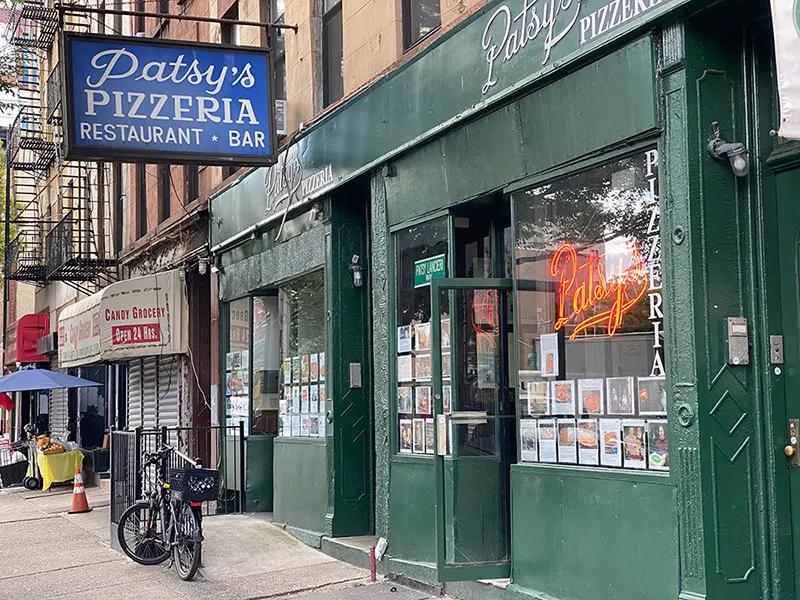
Grimaldi’s
Patsy Grimaldi began working at the original Patsy’s Pizzeria when he was 13-years-old. That’s where he first met “Uncle” Patsy–they wouldn’t be related until the younger Patsy married Carol Lancieri. He also met Frank Sinatra, who according to Patsy Grimaldi, did frequent the Pizzaria, and would even order pizzas delivered to the west coast.
In 1990, Patsy and Carol approached Carmella Lancieri about opening their own pizzeria, named Patsy’s, in Brooklyn Carmella saw no problem with them using the name. After all, they were family.
But then Carmella sold the restaurant to Frank Brija who had other plans. Brija began licensing the name Patsy’s and suing everyone and anyone who dared use the name, nevermind how commonplace it was among Italian immigrants.
The Brooklyn Patsy’s opened at 19 Old Fulton Street in 1990. The area today is a hyper gentrified neighborhood between DUMBO and Brooklyn Bridge Park, but in 1990, not so much. The pizzeria quickly earned praise for its pizza, although it wasn’t yet coal-fired. That came in 1993, when the shop installed a new brick oven. Patsy Grimaldi admitted to Francis X Clines in the New York Times that year that he would break his no delivery rule for Frank Sinatra when he was in town (Sinatra didn’t pass away until 1998).
But soon after reopening, Frank Brija, who now owned the original Patsy’s Pizzeria and had licensed the name to Nick Tsoulos, came calling with his lawyers. Grimaldi at first tried to ward off the legal challenges by changing the name to Patsy Grimaldi’s, and went as far as changing the signage, but that wasn’t enough for Brija, who was also fighting with Patsy’s Italian Restaurant. Grimaldi relented and dropped the name Patsy entirely.
In 1998, the Grimaldi’s sold their now famous coal-fired restaurant to Frank Ciolli. He had been a customer of the pizzeria since it opened 1990. When the lease came up a decade later, Ciolli got into a dispute with the landlord. The neighborhood had changed quite a bit since then, and prices were going up. There was also a dispute over who owed property taxes – commercial leases often require the tenant to pay at least part of the tax liability.
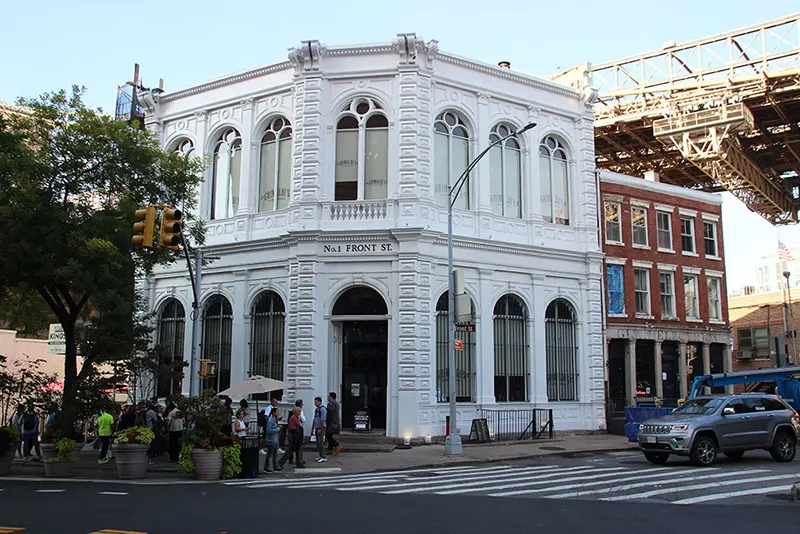
Ciolli decided to relocate to the building next door at 1 Front Street, a former bank. He hired Richard Scarano, an architect at the time who had achieved popularity among residential developers for designing what was ultimately determined to be illegally large apartments.
The real challenge facing Grimaldi’s however, was the coal-fired oven. With coal ovens achieving temperatures far hotter than wood, about 1,000 degrees versus 700 to 800 degrees, it was an essential ingredient. But environmental laws had changed in New York City since Grimaldi’s first opened, and building a new coal oven was harder.
Ciolli didn’t wait for approval and quietly installed his coal oven instead of the gas-fired oven the city had recommended. After an anonymous tip, the department of buildings issued a stop-work order.
Scarano’s questionable architecture practices may have been part of the problem. New York City operated under a self-certification system for architectural plans. To expedite new construction, architects could submit plans and self-certify that they met zoning and building codes. About ten percent of architectural plans ended up under audit, but otherwise the system sped up the approval of buildings. Since Scarano had gotten caught illegally expanding the usable square footage of buildings – he classified loft spaces as storage when it was clear they would be used by owners and tenets for living space – he was under more scrutiny. He had filed architectural plans calling for a pizza oven, but never specified that it would be coal-fired.
The last minute interference delayed the opening of the new shop, but by December, Ciolli had received a permit for his coal oven.
Ciolli blamed none other than Patsy Grimaldi for the stop-work order. While Ciolli was in the process of building out his new pizzeria, Patsy Grimaldi was busy too preparing to take over the space he had once occupied. He was planning on launching a new pizzeria himself, at the age of 81. Unfortunately, he wasn’t legally allowed to use any of his names, having already sold them. The result was Juliana’s, a name that was not trademarked or owned by anyone else, and had once belonged to his mother.
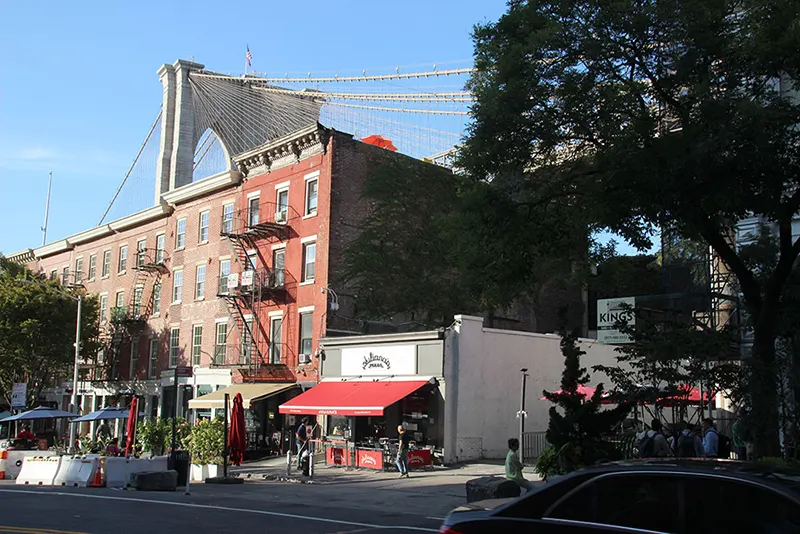
Unsurprisingly, Ciolli, who’s Grimaldi’s restaurant would now be next door to the shop’s founder, was not pleased. He sued. He also complained to the city that Patsy Grimaldi illegally installed a coal-fired oven, delaying the opening of the restaurant. The press made the legal fight out to be a new pizza war, but if that was the case, it was David versus Goliath.
Under Ciolli’s ownership, Grimaldi’s had started building an empire of “brick oven” pizzerias. Ciolli’s son launched the chain with an Arizona restaurant and soon grew the Grimaldi’s brand to more than 40 locations including locations in Hoboken and midtown Manhattan.
At Juliana’s, Patsy Grimaldi and his wife Carol, continued working together every day until Carol’s death in 2014. Patsy turned 90 in 2021, and still showed up at the restaurant.
The two Grimaldi’s businesses remained separate entities until 2019 when the chain bought out the semi-original location.
On a recent visit, Grimaldi’s had a line waiting for tables while Juliana’s was quiet with just a few patrons. A pair of men who had come to eat pizza debated waiting for Grimaldi’s or sitting outside at Juliana’s. They opted to wait on line at Grimaldi’s.

